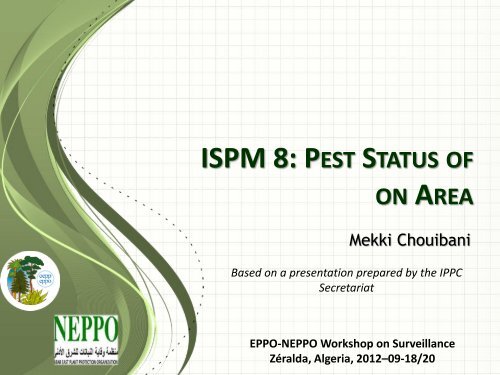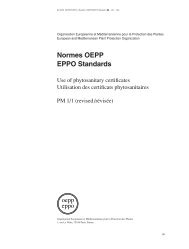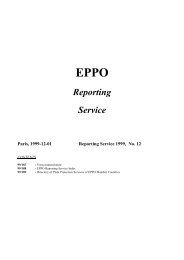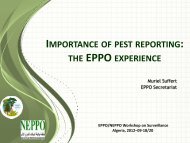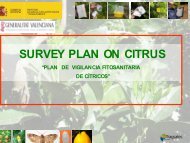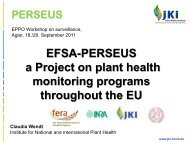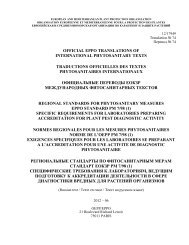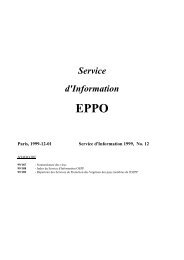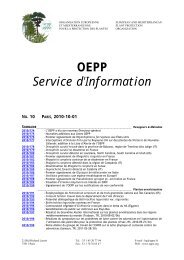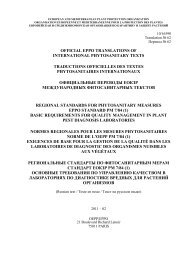ISPM 8: PEST STATUS OF - Lists of EPPO Standards
ISPM 8: PEST STATUS OF - Lists of EPPO Standards
ISPM 8: PEST STATUS OF - Lists of EPPO Standards
Create successful ePaper yourself
Turn your PDF publications into a flip-book with our unique Google optimized e-Paper software.
<strong>ISPM</strong> 8: <strong>PEST</strong> <strong>STATUS</strong> <strong>OF</strong><br />
ON AREA<br />
Mekki Chouibani<br />
Based on a presentation prepared by the IPPC<br />
Secretariat<br />
<strong>EPPO</strong>-N<strong>EPPO</strong> Workshop on Surveillance<br />
Zéralda, Algeria, 2012–09-18/20
Definition:<br />
Pest Status<br />
• Presence or absence, at the present time, <strong>of</strong> a<br />
pest in an area, including where appropriate,<br />
its distribution, as <strong>of</strong>ficially determined using<br />
expert judgement on the basis <strong>of</strong> current and<br />
historical pest records and other information.
Scope <strong>of</strong> Standard<br />
• Describes the content <strong>of</strong> a pest record; the use<br />
<strong>of</strong> pest records and other information in the<br />
determination <strong>of</strong> pest status in an area;<br />
descriptions <strong>of</strong> pest status categories and<br />
recommendations for good reporting practices.
Purposes <strong>of</strong> Pest Status Determination<br />
A pest record is documented evidence<br />
that indicates the presence or absence <strong>of</strong> a<br />
specific pest at a particular location and<br />
certain time, within an area, usually a country,<br />
under described circumstances<br />
Pest records are used with other information<br />
to determine the status <strong>of</strong> a given pest in an<br />
area.
Importing country use <strong>of</strong> information<br />
- to conduct a pest risk analysis (PRA) on a pest<br />
in another country<br />
- to establish phytosanitary regulations to<br />
prevent the entry, establishment or spread <strong>of</strong><br />
a pest<br />
- to conduct a PRA on a non-quarantine pest in<br />
their own territory with a view to regulating it.
Exporting country use <strong>of</strong> information<br />
- to comply with import regulations<br />
- to meet requests for information from other<br />
countries for the purpose <strong>of</strong> PRA on pests in<br />
their territory
Contents <strong>of</strong> a Pest Record<br />
• Current scientific name <strong>of</strong> the organism including,<br />
as appropriate, strain, biotype, etc.<br />
• Life stage or state<br />
• Taxonomic group<br />
• Identification method<br />
• Year, and month if known, recorded; normally the<br />
day will only be required for specific<br />
• Circumstances (e.g. the first detection <strong>of</strong> a<br />
particular pest, pest monitoring)<br />
• Locality, e.g. addresses, geographical coordinates;<br />
greenhouse or open production
Contents <strong>of</strong> a Pest Record cont’d<br />
• Scientific name <strong>of</strong> host, as appropriate<br />
• Host damage, or circumstances <strong>of</strong> collection (e.g.<br />
trap or soil sample), as appropriate<br />
• Prevalence, indication <strong>of</strong> the level <strong>of</strong> pest<br />
presence or pest numbers<br />
• Bibliographical references, if any
Reliability <strong>of</strong> pest records<br />
1. Collectors / Identifiers<br />
a. Taxonomist specialist<br />
b. Scientist<br />
2. Technical identification-<br />
a. Discriminating biochemical or molecular diagnosis<br />
(if available)<br />
b. Specimen or culture maintained in <strong>of</strong>ficial<br />
collection, taxonomic description by specialist<br />
3. Location and date<br />
a. Delimiting or detection surveys<br />
b. Other field or production surveys<br />
4. Recording / Publication<br />
a. NPPO record/RPPO publication (where refereed)
Pest Status in an Area<br />
• Presence- A pest is present if records indicate that it is<br />
indigenous or introduced<br />
– Present: in all parts <strong>of</strong> the area<br />
– Present: only in some areas<br />
– Present: except in specified pest free areas<br />
– Present: in all parts <strong>of</strong> the area where host crop(s) are<br />
grown<br />
– Present: only in some areas where host crop(s) are grown<br />
– Present: seasonally<br />
– Present: but managed / under eradication<br />
– Present: subject to <strong>of</strong>ficial control<br />
– Present: at low prevalence.
Pest Status in an Area<br />
Absence -If there are no records <strong>of</strong> the presence<br />
<strong>of</strong> the pest in the general surveillance data <strong>of</strong><br />
an area, it may be reasonable to conclude<br />
that a pest is or has always been absent.<br />
- no pest records<br />
- pest eradicated<br />
- pest no longer there<br />
- pest record invalid or unreliable
Pest Status in an Area<br />
Transience -Pest status is considered transient when a pest is<br />
present but establishment is not expected to occur based on<br />
technical evaluation.<br />
There are three types <strong>of</strong> transience:<br />
Transient: non-actionable -detected as an individual occurrence or<br />
isolated population not expected to survive and no<br />
phytosanitary measures have been applied.<br />
Transient: actionable, under surveillance - detected and may<br />
survive into the immediate future, but is not expected to<br />
establish. Appropriate phytosanitary measures, including<br />
surveillance are being applied.<br />
Transient: actionable, under eradication - detected and may<br />
survive into the immediate future and, without phytosanitary<br />
measures for eradication, may establish.<br />
Appropriate phytosanitary measures have been applied for its<br />
eradication.
Determination <strong>of</strong> pest status in an area<br />
• Determination <strong>of</strong> the status <strong>of</strong> a pest is<br />
provided by an NPPO. It results in deciding<br />
upon the most appropriate description <strong>of</strong> the<br />
pest status in an area based on supporting<br />
information.<br />
This may include:<br />
• individual pest records<br />
• pest records from surveys<br />
• records or other indication <strong>of</strong> pest absence<br />
• results <strong>of</strong> general surveillance<br />
• information from scientific publications and databases<br />
• phytosanitary measures to prevent introduction or spread<br />
• other information relevant to assessing pest absence or<br />
presence.
Recommended Reporting Practices<br />
• Accurate reports are an essential part <strong>of</strong> the<br />
international cooperation to facilitate trade.<br />
• Failure to discover and report pests, or<br />
inaccurate, incomplete, untimely, or<br />
misinterpreted reports can lead to the<br />
establishment <strong>of</strong> unjustified trade barriers,<br />
or to the introduction and/or spread <strong>of</strong> pests.<br />
• Other standards relevant to pest status <strong>of</strong> an<br />
area are <strong>ISPM</strong> 17 (Pest Reporting) and <strong>ISPM</strong> 19<br />
(Guidelines on lists <strong>of</strong> regulated pests)


